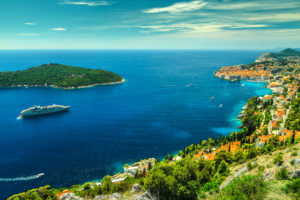Selected from: 33 Mind-Blowing Facts About The Earth’s Oceans
https://bestlifeonline.com/crazy-ocean-facts/
As we all know, the majority of our planet’s surface is covered by oceans. The ocean is a body of saltwater that covers more than 70% of the Earth’s surface. Geographers divide the ocean into five major basins: Pacific, Atlantic, Indian, Arctic, and Southern. Smaller ocean regions are called seas, gulfs and bays, such as the Mediterranean Sea, the Gulf of Mexico, and the Bay of Bengal.
Here are 10 amazing facts about oceans that will leave you bewildered!
- The ocean is home to nearly 95% of all life:
95% of life is aquatic, according to the USA Science & Engineering Festival. That means those of us who live on land are part of a very, very small minority.
- The planet’s longest mountain range is underwater and is 10 times longer than the Andes:

The longest mountain range above water is the Andes, in South America, which is about 4,300 miles long. However, the actual longest mountain range on Earth is the Mid-Oceanic Ridge, which snakes between all continents and clocks in at around 40,390 miles long.
- The Pacific is wider than the moon:
At its widest point, from Indonesia all the way to Colombia, the Pacific Ocean is wider than the moon, by quite a lot. This expanse of ocean is 12,300 miles across, which is more than five times the diameter of the moon!

- Pressure at the bottom of the ocean would crush you like an ant.

In the Mariana Trench (35,802 feet below the surface), which includes the deepest point on the planet, the water pressure is eight tons per square inch. If you made your way down there, it would feel as if you were holding up nearly 50 jumbo jets.
- The planet’s biggest waterfall is in the ocean.

The tallest waterfall you’re going to see on land is Angel Falls in Venezuela, which has a drop of over 3,200 feet. However, that’s nothing compared to the Denmark Strait Cataract, which is an underwater waterfall in between Greenland and Iceland formed by the temperature difference in the water on either side of the strait. When the cold water from the east hits the warmer water from the west, it flows underneath the warm water, with a drop of 11,500 feet. According to the National Ocean Service, the flow rate of the waterfall is more than 123 million cubic feet per second, which is 50,000 times that of Niagara Falls.
- The Mediterranean used to be dry.

The Mediterranean used to be a dry basin until some 5 million years ago during the Zanclean flood—in which water from the Atlantic poured through the Strait of Gibraltar and filled the basin. Theories abound as to how this happened, but one catastrophic interpretation has the basin filling up in only two years, thanks to a massive torrent of water.
- There’s an internet connection in the ocean.
For the past few decades, submarine cables buried deep within the oceans have carried more than 97 percent of intercontinental data traffic—meaning that overseas communication is made possible by ocean-based cables.
- Most of Earth’s volcanic activity happens in the ocean.

When it comes to volcanic activity, the oceans have the most going on by a wide margin. In fact, 90 percent of all the volcanic activity on the planet happens in the ocean, and the largest known concentration of active volcanoes is in the South Pacific: it’s an area no bigger than the size of New York, but it contains a whopping 1,133 volcanoes.
- If all the ice melted, the sea level would rise 26 stories.

According to NASA’s Jet Propulsion Laboratory, if all of the glaciers and sheets of Arctic sea ice melted at the same time, the sea level would rise an estimated 262 feet, which is about the height of a 26-story building—just a bit shorter than the Statue of Liberty.
- The ocean is our greatest source of oxygen.
Most of the oxygen in our atmosphere comes from tiny marine plants in the ocean – specifically, phytoplankton, kelp, and algal plankton. Scientists estimate that they’re responsible for around 70 percent of the atmosphere’s oxygen, according to National Geographic.


